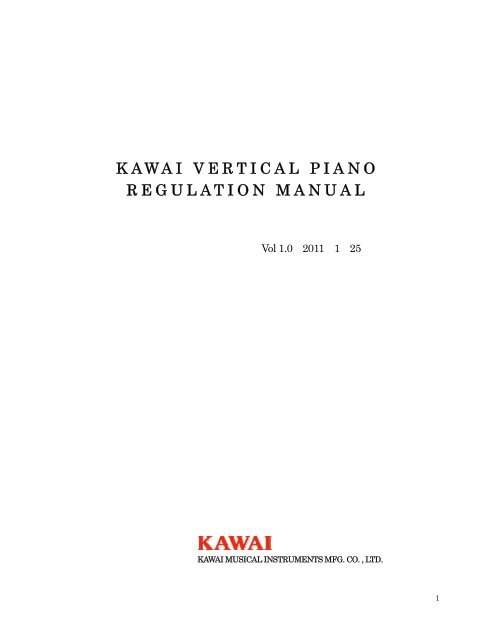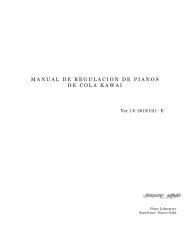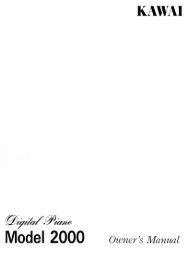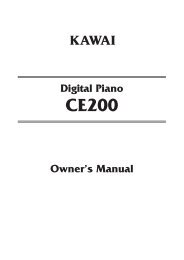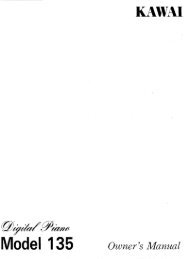kawai vertical piano regulation manual - Kawai Technical Support
kawai vertical piano regulation manual - Kawai Technical Support
kawai vertical piano regulation manual - Kawai Technical Support
You also want an ePaper? Increase the reach of your titles
YUMPU automatically turns print PDFs into web optimized ePapers that Google loves.
KAWAI VERTICAL PIANO<br />
REGULATION MANUAL<br />
Vol 1.0 2011 1 25<br />
KAWAI MUSICAL INSTRUMENTS MFG. CO. , LTD.<br />
1
Regulation Process Index<br />
1 Tighten Screws, Check Action, Strike Point, Hammer Blow・・・・・P3<br />
2 Keys ・・・・・・・・・・・・・・・・・・・・・・・・・・・・・・P4<br />
3 Travel, Angle Hammers・・・・・・・・・・・・・・・・・・・・・・P5<br />
4 Fit Hammers to Strings and Align ・・・・・・・・・・・・・・・・P6<br />
5 Lost Motion・・・・・・・・・・・・・・・・・・・・・・・・・・・P7<br />
6 Hammer Let Off ・・・・・・・・・・・・・・・・・・・・・・・・・P8<br />
7 Key Height ・・・・・・・・・・・・・・・・・・・・・・・・・・・P9<br />
8 White Key Dip ・・・・・・・・・・・・・・・・・・・・・・・・・P10<br />
9 Backstop, Black Key Dip ・・・・・・・・・・・・・・・・・・・・P10<br />
10 Damper・・・・・・・・・・・・・・・・・・・・・・・・・・・・・P11<br />
11 Soft Pedal and Bridle Straps, Wires ・・・・・・・・・・・・・・P13<br />
12 Muffler Pedal ・・・・・・・・・・・・・・・・・・・・・・・・・P14<br />
2
1. Tighten Screws, Check Action, Strike Point, Hammer Blow<br />
Tighten all Screws in Plate, Case, Action, and<br />
Bench. Check Action Centers for loose or tight<br />
fit. If loose, repin with a larger pin. If tight,<br />
ream the bushing and replace the pin. Make<br />
sure all Springs are in position and<br />
functioning.<br />
Check Action Friction, and make sure all<br />
parts move smoothly.<br />
Hammer No. 88 should strike the string<br />
2.0mm - 2.7mm from the capo bar. The final<br />
position should be chosen by the sound.<br />
If necessary adjust action support bolt up or<br />
down. After changing the support bolt, bend<br />
the action bracket bolt at the top up or down<br />
to keep the action held in position tightly.<br />
Hammer blow distance should be 46mm.<br />
Measure from the tip of the hammer to the<br />
strike point on the strings.<br />
Set the blow distance to 46mm by increasing<br />
or decreasing the thickness of the felt block<br />
between the hammer rest rail and action<br />
brackets.<br />
3
2. Keys<br />
Space and square: Make the keys parallel and<br />
straight at the front by tapping the balance<br />
rail pin to one side or the other.<br />
Then space the keys by bending the front rail<br />
pin to one side or the other with a spacing tool.<br />
CAUTION: For spacing the keys, put the<br />
spacing tool below the felt punching to avoid<br />
nicking the pin.<br />
Key Front Bushings: Inspect keys by<br />
depressing each key fully and moving side to<br />
side while holding the balance rail to prevent<br />
rocking at the balance rail bushing. There<br />
should be very slight lateral movement.<br />
Ease or re-bush keys as necessary<br />
Key Balance Bushings: Place fingers on front<br />
and back of key button. Move from side to<br />
side. Again, there should be slight lateral<br />
movement. Ease or re-bush as necessary.<br />
Key Balance Hole: Inspect keys to see that<br />
they will fall of their own weight when lifted<br />
at the front and lightly held at the back.<br />
If they are too tight they can be eased.<br />
Only ease the sides of the hole if needed by<br />
turning the easing tool inside the key 90º after<br />
inserting through the bushing.<br />
If the balance hole is loose on the pin, apply a<br />
few drops of alcohol and water (Isopropyl 70%)<br />
to the hole then set aside. Once it is dry,<br />
re-fit it to the pin.<br />
4
3. Travel, Angle Hammers<br />
Push the Hammer rest rail towards the<br />
strings and look for sideways movement as<br />
the hammer travels to the string.<br />
Place a piece of travel paper between the<br />
flange and hammer rail on the opposite side of<br />
the screw that the hammer is traveling to.<br />
Use different thickness or length of paper<br />
strips under the flange to determine the<br />
degree of correction.<br />
Check hammer angle – spaces between<br />
hammers must be equal and parallel at the<br />
“rest” position and “strike” position.<br />
If an error is detected then the shank can be<br />
heated up and then carefully and very gently<br />
twisted back into the correct alignment<br />
position.<br />
CAUTION: Do not use excessive force as this<br />
will stress the flange and possibly damage the<br />
bushings. Only use the blue flame to heat the<br />
wood, because the red portion of the flame will<br />
leave black marks.<br />
5
4. Fit Hammers to Strings and Align<br />
Push the hammer forward against the strings<br />
by pressing on the catcher with your fingers.<br />
Center the Hammers to the string by<br />
loosening the flange screw and shifting the<br />
hammer over and re-tightening the screw.<br />
Space all Hammers.<br />
Push the hammer against the strings again<br />
and pick the strings to check for proper fitting.<br />
Each hammer should touch all strings with<br />
the same pressure. If some strings are<br />
dampened by the hammers but others are not,<br />
lightly file the hammer top to even the<br />
pressure on the strings.<br />
6
5. Lost Motion<br />
Align Wippens: the jack should be centered<br />
under the butt, and the capstan under the<br />
wippen.<br />
To change the lateral position of the wippen,<br />
loosen screw and shift the wipppen.<br />
To change the position of the jack tail under<br />
the let-off button, paper the side of the wippen<br />
flange that you want the jack tail to move<br />
towards.<br />
If Capstans have Wires, Space and Align<br />
Capstan Post.<br />
Center the Capstans to the Wippen heel.<br />
(left or right)<br />
Center the Capstans to the Wippen heel.<br />
(front or back)<br />
Regulate Capstans: Check by pulling back<br />
slightly on the hammer rest rail. The<br />
hammers should follow very slightly.<br />
When pressing the key down very slowly, the<br />
backcheck and catcher should start move at<br />
same time. If the backcheck moves first then<br />
there is too much lost motion.<br />
Tap down on the back of the keys. If hammers<br />
move, the capstans should be turned down for<br />
more lost motion.<br />
7
6. Hammer Let Off<br />
Adjust the jack stop rail (sometimes combined<br />
with the letoff rail) so that when a key is<br />
firmly pressed there is at least 1mm space<br />
between jack and felt cushion rail.<br />
Failure to have adequate clearance will cause<br />
wippen to hang up on a hard blow.<br />
If you move the regulating rail, be careful to<br />
keep the letoff buttons centered over the Jack<br />
tails.<br />
Let-Off should be 2.0 mm in the treble,<br />
2.5 mm in the middle,<br />
3.0 mm in the bass.<br />
Adjust Regulating screw for correct letoff<br />
while playing the key slowly and watching the<br />
hammers.<br />
8
7. Key Height<br />
Check the Key Height from top of the Keyslip<br />
20mm ~22mm<br />
If most keys need to be raised or lowered, add<br />
or remove shims (thick cardboard or wood<br />
veneer) under balance rail at the hold-down<br />
screw locations.<br />
Set both end white keys to correct height by<br />
placing paper punchings under the keys and<br />
cloth punchings.<br />
Using a straightedge, mark the low and high<br />
spots with chalk for which size punching will<br />
be needed. Remove each key and place paper<br />
punchings under the keys and cloth<br />
punchings.<br />
Repeat as necessary until keys are level.<br />
Set both end black keys to 12mm above the<br />
white keys.<br />
Level as with white keys.<br />
9
8. White Key Dip<br />
Whites: Using a 10.3 mm dip block, depress<br />
each key and compare with the height of the<br />
neighboring key. Add or remove paper<br />
punching until desired dip is achieved.<br />
NOTE: Make certain the same pressure is<br />
used throughout the keyboard. Move back and<br />
forth to re-check your finger pressure as you<br />
regulate.<br />
Another way to double check for evenness is to<br />
push down 3 keys with 3 fingers using the<br />
same light pressure and check if keys are<br />
level. Thicker card and paper should be lowest<br />
on the pin, thinner paper upper. There should<br />
be no more than 4 of any one thickness paper.<br />
9. Backstop, Black Key Dip<br />
Space the backchecks to the catchers by<br />
bending backcheck Wires.<br />
Square backchecks to catchers.<br />
10
Set backchecks on white keys so the hammers<br />
check 15mm from the strings on a medium mf<br />
blow.<br />
After the white key backchecks are set, align<br />
the black key backchecks to match the white<br />
notes using a straightedge. All backchecks<br />
should be in a straight line.<br />
Once the backchecks are aligned, set the black<br />
key dip so that the hammers catch the same<br />
15mm distance from the strings, matching the<br />
white keys<br />
10. Damper<br />
Alignment: Adjust damper wires so that the<br />
damper felts are seated squarely on the<br />
strings.<br />
Check the damper function by playing the<br />
notes staccato.<br />
Lift by Pedal: Damper wires must be regulated<br />
in or out, allowing all dampers to lift evenly<br />
with the the pedal.<br />
11
Lift by Key: Damper should lift with the key<br />
when hammer is halfway through its travel.<br />
Bending the damper spoon toward the strings<br />
causes the damper to lift earlier; toward the<br />
action causes later lift.<br />
Adjust the damper pedal (and bass sustain, if<br />
any) to allow slight lost motion before the<br />
dampers lift from the strings.<br />
The Dampers should follow the string when<br />
the string is pushed lightly.<br />
When keys are played and the hammers are<br />
in check, make sure there is 2 – 4mm space<br />
between damper wires and damper stop rail<br />
felt.<br />
To adjust, bend the damper stop rail mounting<br />
fork (if applicable), or add / remove paper<br />
punchings between the damper stop rail and<br />
action bracket.<br />
12
11. Soft Pedal and Bridle Straps, Wires<br />
Adjust Soft Pedal: set it so there is 2mm lost<br />
motion between hammer rest rail and pedal<br />
rod.<br />
Adjust Pedal Prop Bolt Nut<br />
Bridle Wires Side to Side:<br />
Align the bridle wires evenly in between the<br />
two backcheck wires (for this note and the<br />
neighboring note) to make sure the bridle<br />
tapes never touch the backcheck wires.<br />
Bridle Wires Front or Back:<br />
Bridle Wires should be as tight as possible<br />
without causing the wippens to be lifted when<br />
the soft pedal is pressed firmly all the way<br />
down.<br />
13
12. Muffler Pedal<br />
Install Muffler<br />
Regulate muffler pedal adjusting nut so that<br />
the muffler felt clears all hammers when the<br />
pedal is disengaged, but the felt moves down<br />
far enough in front of the hammers to mute<br />
the sound when the pedal is engaged. After<br />
adjusting, turn the lock ring down tightly<br />
against the mounting block.<br />
Muffler rail (disengaged)<br />
Muffler rail (engaged)<br />
14


